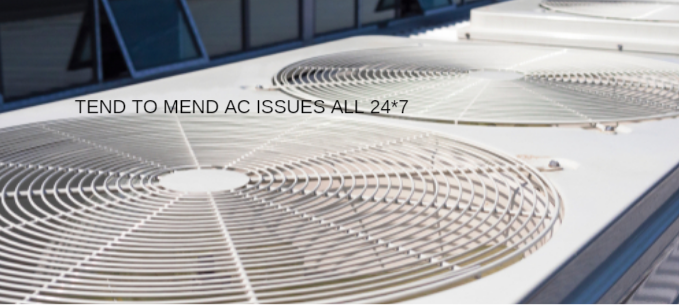Unveiling the Secrets of Next-Gen Air Conditioning Tech
In a world where comfort meets innovation, air conditioning technology continues to evolve and reshape our indoor climate control expectations. Beyond the familiar hum of traditional air conditioning units lies a realm of possibilities that promise enhanced efficiency, unprecedented comfort, and a commitment to sustainability.
In an era where AC technology is evolving at a brisk rate, you can count on our AC Repair Hollywood FL experts. They diligently stay updated with the latest innovations, ensuring top-notch service and efficiency for your cooling needs.
Ahead in this blog, we’ll uncover the secrets behind next-gen air conditioning tech, exploring the advancements defining the future of staying cool.

Variable Refrigerant Flow (VRF) Systems:
Enter the world of Variable Refrigerant Flow (VRF) systems, where air conditioning becomes a personalized experience. Unlike their traditional counterparts, VRF systems can adapt in real-time, providing precise temperature control and minimizing energy wastage. Picture a scenario where every nook and cranny of a large space enjoys the perfect climate, thanks to VRF’s intelligent distribution of refrigerant flow. This technology isn’t just about cooling but transforming how we think about energy efficiency in air conditioning.
VRF systems operate on a variable-speed compressor, adjusting the refrigerant flow based on the load requirements. This dynamic process not only ensures optimal comfort but also contributes significantly to energy savings. Businesses and residential spaces are embracing VRF technology for its ability to maintain consistent temperatures while being environmentally conscious.
As we delve deeper into the realm of VRF systems, it’s essential to appreciate the real-world applications that showcase their effectiveness. From large commercial spaces like shopping malls and office buildings to smaller residential complexes, VRF systems are making waves in the air conditioning landscape. The adaptability and efficiency of VRF technology underscore its role as a cornerstone in the evolution of next-gen air conditioning.

Smart Thermostats and IoT Integration:
Let’s delve into the seamless integration of smart thermostats and the Internet of Things (IoT) with air conditioning units. Envision a scenario where your air conditioner goes beyond being a mere machine and becomes a savvy companion that understands and anticipates your comfort preferences. This assurance is provided by smart thermostats, which, in conjunction with IoT technology, take the air conditioning experience to new levels.
Smart thermostats provide user-friendly controls for creating personalized schedules, monitoring and adjusting temperatures remotely, and even receiving insights into energy consumption. The collaboration with IoT ensures your AC isn’t just linked to your smartphone but also part of a network of devices working together to optimize energy usage. This connectivity yields concrete benefits, such as reduced energy costs and a more sustainable approach to cooling our living spaces.
An essential feature of smart thermostats is their capacity to learn user preferences over time. These devices adapt to your routine through machine learning algorithms, ensuring your space is always at the right temperature when needed. The simplicity of use and the potential for significant energy savings make smart thermostats an integral component of the next-gen air conditioning landscape.
The environmental impact of these technologies is noteworthy. By enabling users to monitor and control their air conditioning systems remotely, smart thermostats and IoT integration contribute to more responsible energy consumption. It not only benefits individual users but also aligns with broader efforts to create sustainable and energy-efficient urban environments.

Nanotechnology in Air Filters:
As we progress, let’s shift our focus to the invisible heroes of next-gen air conditioning – nanotechnology-infused air filters. These filters represent a breakthrough in addressing air quality concerns by leveraging the power of microscopic particles to enhance filtration capabilities.
Traditional air filters have limitations when it comes to capturing ultrafine particles, including allergens and pollutants. Nanotechnology, with its focus on manipulating materials at the nanoscale, introduces a new frontier in air purification. These advanced filters utilize nanomaterials to create a highly efficient barrier, capturing particles that would otherwise escape traditional filters.
The benefits of nanotechnology in air filters extend beyond the basic function of trapping particles. By providing superior filtration, these filters improve indoor air quality, reducing the risk of respiratory issues and allergies. Nanotechnology-infused air filters offer a welcomed solution for individuals with sensitivities to airborne particles, such as pollen or pet dander.
The long-term advantages of incorporating nanotechnology in air conditioning systems are evident. Reduced exposure to pollutants and allergens can lead to improved health outcomes, making these systems not only a technological marvel but also a valuable asset for overall well-being. As we continue to unravel the secrets of next-gen air conditioning, the role of nanotechnology in ensuring cleaner and healthier indoor environments stands out as a key component in the pursuit of optimal living conditions.
Solar Powered Air Conditioning:
In our shift towards sustainable solutions, let’s delve into the potential of solar-powered air conditioning to revolutionize our approach to cooling technology. In an era where environmental awareness is crucial, leveraging solar energy for air conditioning systems marks a significant step towards a greener and more sustainable future.
Solar-powered air conditioning systems convert solar energy into electricity to drive the cooling process. This approach diminishes reliance on traditional energy sources, leading to a reduced carbon footprint and less strain on conventional power grids. The incorporation of solar technology into air conditioning aligns seamlessly with the global drive for renewable energy solutions.
A key benefit of solar AC systems lies in their potential for cost savings. While the initial installation costs may be higher, the long-term advantages include lower energy bills and, in certain cases, the ability to sell surplus energy back to the grid. Businesses and homeowners seeking to embrace sustainable practices find solar-powered air conditioning an appealing option, blending comfort with a commitment to environmental responsibility.
However, it’s essential to acknowledge the challenges and advancements in solar-powered air conditioning. Efficiency is a critical factor, as the effectiveness of these systems relies on sunlight availability. Advancements in energy storage and improved solar panel technologies are addressing these challenges, making solar-powered air conditioning an increasingly viable and impactful choice for those seeking eco-friendly alternatives.
As we navigate the landscape of next-gen air conditioning, the integration of solar technology emerges as a beacon of sustainability. By tapping into the boundless energy of the sun, these systems represent a harmonious fusion of comfort and environmental responsibility, paving the way for a future where staying cool is synonymous with staying green.

Artificial Intelligence for HVAC Optimization:
Finally, let’s explore the transformative role of Artificial Intelligence in optimizing HVAC systems. AI-driven HVAC optimization goes beyond traditional programming by incorporating machine learning algorithms. These algorithms analyze data from various sources like user behavior, weather forecasts, and system performance to make real-time intelligent decisions. It helps the system operate efficiently while ensuring it evolves over time to become more attuned to user preferences and environmental conditions.
Predictive maintenance is a standout feature of AI in HVAC systems. By continuously monitoring the health of the equipment, AI can identify potential issues before they escalate, reducing the likelihood of unexpected breakdowns and prolonging the system’s lifespan. This proactive approach not only saves costs on repairs but also ensures uninterrupted comfort for users. However, remember that AC Repair Hollywood FL experts are just a call away from you.
Adaptive cooling is another dimension where AI shines. Instead of relying on fixed temperature settings, AI-driven systems analyze usage patterns and adjust cooling levels accordingly. It not only enhances comfort but also contributes to energy efficiency by avoiding unnecessary cooling when it’s not needed.
Real-world applications of AI in HVAC optimization span a range of environments, from commercial buildings to smart homes. Businesses benefit from improved energy efficiency and reduced operational costs, while homeowners enjoy a more personalized and adaptive indoor climate. As we witness the integration of AI into air conditioning technology, we’re stepping into an era where our comfort is not just automated but intelligently curated.
Final Words
In conclusion, the secrets of next-gen air conditioning tech are unveiled through the lenses of innovation, sustainability, and efficiency. From the precision of VRF systems to the connectivity of smart thermostats, the purity of nanotechnology-infused air filters, the sustainability of solar-powered air conditioning, and the intelligence of AI-driven HVAC optimization, each technological facet contributes to a future where staying cool is synonymous with staying ahead.
Reach out to the professionals of AC repair Hollywood FL to explore how you can integrate these features into your existing air conditioner. Remember, the ultimate air conditioning comfort is just a call away from you. Embrace the evolution, stay informed, and welcome the future of cool with open arms.


























